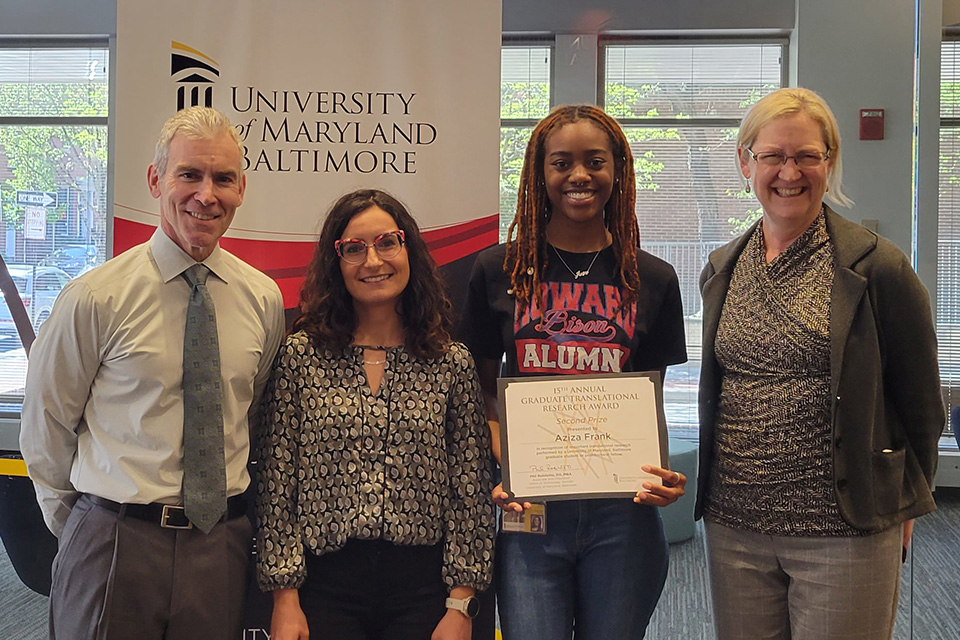UMSOP Faculty Awarded $2.8 Million NIH Grant to Improve Chemotherapy for Triple-Negative Breast Cancer
Researchers aim to improve chemotherapy by enhancing drug efficacy and reducing heart toxicity through dual activation of CAR and Nrf2 pathways.

By Pam Carder
September 10, 2025
Two faculty members from the University of Maryland School of Pharmacy (UMSOP) have received a $2.84 million grant from the National Institutes of Health (NIH) to explore a novel therapeutic strategy aimed at enhancing the efficacy of and reducing the toxicity of a widely used chemotherapy regimen for triple-negative breast cancer (TNBC).
The five-year R01 grant, titled “Impact of CAR and Nrf2 Dual Activation on Cyclophosphamide Bioactivation and Doxorubicin Detoxification,” was awarded to Hongbing Wang, PhD, professor and interim chair of the Department of Pharmaceutical Sciences (PSC), and Fengtian Xue, PhD, professor of PSC and associate dean for research.
Targeting a Difficult-to-Treat Cancer
Triple-negative breast cancer is an aggressive and hard-to-treat subtype of breast cancer that often does not respond to hormonal or targeted therapies. Patients are typically treated with a combination of cyclophosphamide (CPA) and doxorubicin (DOX) – a regimen that, while effective for some, can lead to serious side effects and treatment resistance.
Wang and Xue, along with collaborators from the University of Maryland and Michigan State University, aim to improve the efficacy-to-toxicity ratio of CPA/DOX chemotherapy by investigating how dual activation of two key molecular pathways – constitutive androstane receptor (CAR) and nuclear factor erythroid 2–related factor 2 (Nrf2) – can simultaneously boost cancer-killing activity and reduce heart-related toxicity.
“This grant supports a bold and highly translational approach to cancer therapy,” said Wang, who serves as principal investigator on the project. “Our goal is to turn existing limitations of chemotherapy into opportunities by using newly developed small molecules to optimize drug activation in the liver while shielding the heart from damage.”
Innovative Research Model and Promising Compounds
The team has already identified a promising lead compound, YA9073, which shows strong potential to activate both CAR and Nrf2 pathways. With the new NIH funding, the research team will further test YA9073 and related compounds across several models – including human liver and heart cell cultures as well as transgenic mouse models – to assess their impact on drug metabolism, anti-cancer efficacy, and toxicity profiles.
“This research leverages a multidisciplinary approach – combining medicinal chemistry, pharmacology, and advanced disease modeling – to answer a critical question in oncology drug development,” said Xue, who will serve as multiple principal investigator (MPI). “We hope that dual activation of CAR and Nrf2 will pave the way for a new generation of safer and more effective chemotherapies, not only for TNBC, but potentially for other malignancies treated with CPA/DOX regimens.”
Collaboration Across Institutions
The project team includes:
- Hongbing Wang, PhD (Contact PI, University of Maryland School of Pharmacy)
- Fengtian Xue, PhD (MPI, University of Maryland School of Pharmacy)
- Alex MacKerell, PhD (Co-Investigator, University of Maryland School of Pharmacy)
- Stuart Martin, PhD (Co-Investigator, University of Maryland School of Medicine)
- Kate Tkaczuk, MD (Co-Investigator, University of Maryland School of Medicine)
- Charles Hong, MD, PhD (Co-Investigator, Michigan State University)
Members bring complementary expertise in drug metabolism, molecular pharmacology, computer-aided drug design, cancer biology, and therapeutic development, enhancing the project’s potential to translate laboratory findings into clinical applications.
A Step Toward Precision Chemotherapy
This research may represent the first therapeutic strategy to deliberately combine CAR activation for drug bioactivation with Nrf2 activation for detoxification, offering a precision-medicine approach to chemotherapy optimization.
“The long-term impact of this work could be transformative,” said Wang. “By refining how drugs are metabolized and reducing systemic toxicity, we can improve patient outcomes and quality of life – two of the most critical measures in cancer treatment.”



